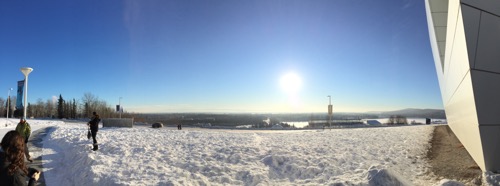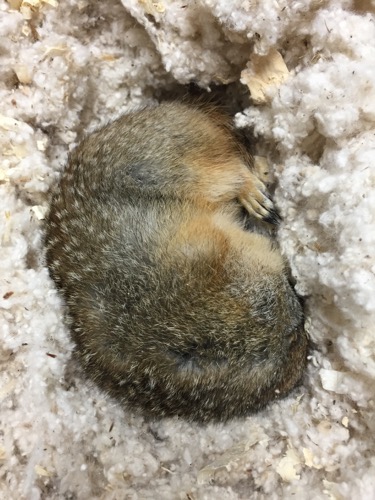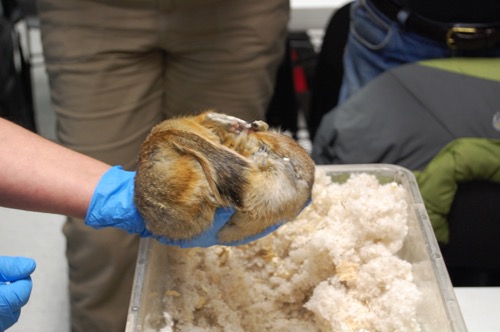Hibernation Habits
The Arctic ground squirrel (Spermophilus parryii) is a species of rodent that lives in the Arctic year-round. This small mammal does not spend the entire year exploring the frozen Arctic. Instead, this species of squirrel heads into its burrow in late summer and hibernates for at least eight months before emerging in the spring to mate and forage for food. On Tuesday, as part of our third day of PolarTREC orientation, we traveled to the Museum of the North at the University of Alaska Fairbanks (UAF) to meet with researcher Jeanette Moore and one of her lab squirrels. Jeanette's research (from both Toolik Field Station in northern Alaska and in her laboratory at UAF) focuses on the physiology of the squirrel's winter hibernation.
 View of Fairbanks from UAF Museum of the North
View of Fairbanks from UAF Museum of the North
A Long Winter's Nap
During this hibernating process, these ground squirrels are busy doing....NOTHING. I'm not joking. According to data processed by the team from UAF, these ground squirrels show dramatic reductions in the following:
- Heart rate
- Blood pressure
- Body temperature (near or below freezing)
- Brain activity (no measured activity at certain times during hibernation!)
These physiological activities remain slow for most of the hibernation period. The only exception is once a month when the squirrels appear to 'wake up' in order to increase their body temperature for a 24-hour period. The reason behind this short recovery period is still under investigation, along with many other interesting questions about this small animal. Some of these questions focus on physiology, but also look at how the changing climate in the Arctic is affecting the hibernation, and ultimately the mating and foraging activity of these squirrels. When I head to Antarctic in September, I will be on the other side of the Earth looking at microscopic organisms in the Southern Ocean (SO). Regardless of where the research is conducted or the type (or size) of organism that the research is focused on, the over-arching goal is still the same. Data from these research opportunities are vital in understanding how climate change is not only affecting the sleeping habits of squirrels or the growth of diatoms, but ultimately how the physical and biological processes on Earth are handling changes to their climate, changes to their chemistry, etc. I am excited to learn more examples of polar research that are helping to shape our understanding of climate change and I am proud to be a part of this research.
 Arctic ground squirrels hibernate below ground in the wild. At the University of Alaska Fairbanks, the squirrels make nests in plastic crates.
Arctic ground squirrels hibernate below ground in the wild. At the University of Alaska Fairbanks, the squirrels make nests in plastic crates.
 An Arctic ground squirrel curled up in a ball while sleeping in a nest.
An Arctic ground squirrel curled up in a ball while sleeping in a nest.
 Jeanette Moore from UAF carefully lifts a sleeping, female Arctic ground squirrel from its nest.
Jeanette Moore from UAF carefully lifts a sleeping, female Arctic ground squirrel from its nest.
Making New Friends
As part of the experience, Jeanette allowed PolarTREC teachers and staff to hold one of the hibernating squirrels. Even after a being passed between people and lots of flash bulbs, the body of the squirrel was still quite cold (they hibernate in freezers in the lab). The squirrel only moved occasionally because it could take about 3 hours for it to wake up! It reminded me of a Monday morning biology class with my sophomores - it takes the students about 3 hours to wake up, too. Arctic ground squirrels have more in common with high school students than one would think.
 Cara Pekarcik holds a sleeping ground squirrel during a visit to the University of Alaska Fairbanks. Photo taken by Dominique Richardson.
Cara Pekarcik holds a sleeping ground squirrel during a visit to the University of Alaska Fairbanks. Photo taken by Dominique Richardson.
Vocabulary
- Hibernate/Hibernation - To reduce activity and metabolic rate
- Forage - To search for food
- Physiology - The study of normal body functions
- Diatoms - Unicellular, photosynthetic plankton
Look for much more information on diatoms in future journals


Comments